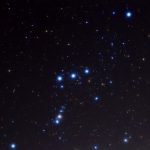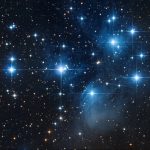 Did you know winter is one of the best times to stargaze? That's right! Ready to bundle up and find out why?
Did you know winter is one of the best times to stargaze? That's right! Ready to bundle up and find out why?
- Cold winter air holds less moisture, making clear nights even clearer than those warm summer nights. But a very clear night can have the opposite effect, when the stars "twinkle" too much from atmospheric disturbance, or if it is windy, it will be hard to see stars clearly through a telescope or binoculars.
- Longer nights, and an earlier darkness, make for better and longer stargazing opportunities. Try to pick a moonless night.
- Introduce your kiddos to the wonders of the night sky without interrupting their bedtime routine...as much.
- If you happen to be up north, usually above the continental United States, you might see the Northern Lights (view the University of Alaska's Aurora Forecast, opens a new window to see projected geomagnetic activity).
- There are different stars visible in the winter than the summer, so make winter stargazing a new tradition!
Here are some celestial happenings you'll find in the night sky.
 Orion
Orion
Look for Orion's iconic belt in the southwest sky. If you look off to the constellation's left shoulder, you'll notice a red star. That's Betelgeuse—visible in this photo—a supergiant star that's slowly nearing the end of its life (in the next 100,000 years, that is). If you have a telescope, focus on the cluster of stars below Orion's belt; that's the Orion Nebula. And then from Orion's belt, look to the left and down (about eight of Orion's "belt lengths") to find Sirius.
 Sirius, the brightest star in the night sky
Sirius, the brightest star in the night sky
That's right, Sirius, or the dog star (hey Harry Potter fans, see what J.K. Rowling did there?), is the brightest star visible from Earth. It's part of the constellation Canis Major. The best time to see Sirius is in the southern skies from winter until mid-spring, particularly in February. Sirius is sometimes reported as a UFO because its colors change and flicker; all stars flicker because of how light passes through the Earth's atmosphere, but the effect is particularly noticeable because of Sirius's brightness. Sirius is the bright star in the lower left corner of this photo.
 The Pleiades
The Pleiades
You'll find the Pleiades if you follow the stars in Orion's belt upward in a straight line. You'll see a bright star called Aldebaran, the eye of the bull Taurus, and then just a bit beyond that, you'll see the Pleiades, a small star cluster, shaped sort of like a dipper. The Greeks referred to these stars as the Seven Sisters. In Japanese, this cluster is called "Subaru" (next time you see a Subaru on the road, look at its logo). Also nearby is the Crab Nebula, the remnant of a star that exploded in 1054, and noted by Chinese, Korean, Arab and Japanese astronomers who recorded that the star's brightness was even visible during the day.
Meteors and Meteor Showers
If you wait long enough, you'll likely see a meteor or two pass by. These meteors are caused by the Earth passing through a comet's leftover space dust and debris. Check out the Leonids which peak the night of November 17-18, 2021, the Geminids which peak the night of December 13-14, 2021, the Ursids which peak the night of December 21-22, 2021, and the Quadrantids which peak the night of January 2-3, 2022. Visit the American Meteor Society's Meteor Shower Calendar, opens a new window for updated information year by year, as peak times can vary by a few days.
Planets
Do you know how to tell a planet apart from a star? A star will twinkle, a planet will not. Look for Mars soon after sunset in the east-northeast sky. Jupiter and Saturn rise later in the evening, in the southwest sky. With a pair of powerful binoculars or a telescope, you might be able to see Saturn's rings. Venus, the brightest planet, is visible during the predawn hours in the east-southeast.
Cold Weather Tips
- Wear plenty of layers, especially taking care of your hands, feet and head with warm socks, mittens or gloves, and hats. If you have a telescope or binoculars, you might want a pair of thinner gloves when setting up to help manipulate your instruments.
- Wear waterproof clothing to protect against snow and ice, like a ski parka and ski pants and insulated boots.
- Bring warm blankets and heat pads, a must when you are standing still for long periods of time. Try to move around if you feel chilled or bring a hot beverage to drink.
- If you're standing on a snowy area, try to clear away as much snow as you can to keep your feet warmer and to prevent any slips or spills.
More to Explore
- Learn about the Apollo 11 moon landing.
- Learn about space and astronomy using a STEAM Kit.
If you want more skywatching tips or sights to see, check out astronomy and stargazing books and movies for all things relating to the night sky.


Add a comment to: Winter Stargazing